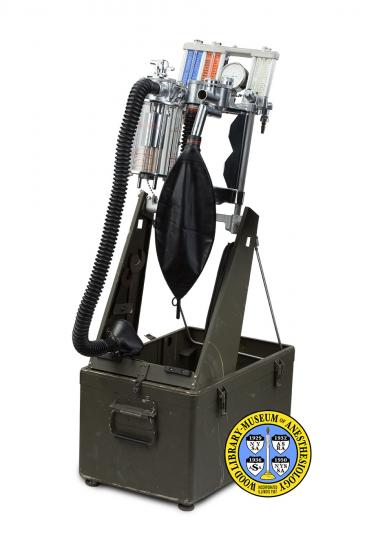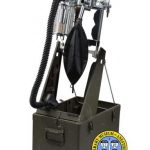Ohio 785
The Ohio Model 785 Field Anesthesia Machine was adopted by the U. S. Army in 1967, and replaced the use of the older Model 685 in the Vietnam War (1956-1975). Unlike its predecessor, the Model 785 was integrated with its carrying case, so that less assembly was required. The entire unit was designed to withstand being air-dropped into remote locations. It was built to administer cyclopropane as well as nitrous oxide, oxygen and ether. But cyclopropane, an explosive agent, was not ideal in a field hospital setting. Use of that agent was soon discontinued, and replaced by adding a Fluotec halothane vaporizer to the machine. Before the end of the Vietnam War, the next generation of military anesthesia equipment, the Model 885, was already being tested.
Catalog Record: Ohio 785
Access Key: akxk
Accession No.: 1993-03-10-1 B
Title: Model 785 / Ohio.
Corporate Author: Ohio Chemical & Manufacturing Company.
Title variation: Alt Title
Title: Ohio 785 field anesthesia machine.
Publisher: Madison, Wisconsin : Ohio, [between 1967 and 1972].
Physical Descript: 1 anesthesia machine : metals, plastics, glass, rubber, paint ; 105 x 37 x 54.5 cm.
Subject: Anesthesia Machines.
Subject: Military Medicine.
Subject: Nitrous Oxide.
Subject: Cyclopropane.
Subject: Halothane.
Subject: Vaporizers.
Note Type: General
Notes: The date range for the possible year of manufacture was taken from table II:
military field anesthesia machines, page 71, of CDR Clayton Petty’s 1990
article, “Historical Perspective on the Evolution of Today’s Military Field
Anesthesia Machine.” The date range could change if documentation indicates
the range should be corrected.
Note Type: Citation
Notes: Condon-Rall ME. A brief history of military anesthesia. In: Zajtchuk R,
Grande CM, eds. Anesthesia and Perioperative Care of the Combat Casualty.
Falls Church, Virginia: Office of the Surgeon General, United States Army;
1995:885-896.https://ke.army.
mil/bordeninstitute/published_volumes/anesthesia/ANch31.pdf. Accessed
September 22, 2014.
Note Type: Citation
Notes: Jenicek JA, Perry LB, Thompson GE. Armed forces anesthesiology comes of age.
November/December, 1967;46(6):822-832. https://journals.lww.
com/anesthesia-analgesia/Citation/1967/11000/Armed_forces_anesthesiology_come
_of_age_.24.aspx. Accessed September 22, 2014. {Article is mostly about the
785, with other ttopics of historical interest.]
Note Type: Citation
Notes: Lichtmann MW. Military and battlefield anesthesia: part 1: Vietnam. In:Crande
CM, ed. Textbook of Trauma Anesthesia and Critical Care. St. Louis: Mosby;
1993:1299-1303.
Note Type: Citation
Notes: Model 785: … Instruction and Service Manual with Illustrated Parts List.
Madison, Wisconsin: Ohio Chemical and Surgical Equipment Company; October,
1968.
Note Type: Citation
Notes: Petty C. Historical perspective on the evolution of today’s military field
anesthesia machine. Military Med. 1990;155(2):66-71.
Note Type: Citation
Notes: Petty WC. Military anesthesia machines. In: Zajtchuk R, Grande CM, eds.
Anesthesia and Perioperative Care of the Combat Casualty. Falls Church,
Virginia: Office of the Surgeon General, United States Army; 1995:141-142.
https://ke.army.mil/bordeninstitute/published_volumes/anesthesia/ANch7.pdf.
Accessed September 22, 2014. [Pre-Ohio Model 885 machines.]
Note Type: Physical Description
Notes: One military field anesthesia machine that packs into a carrying case for
transport; For descriptive purposes, the side where the connections for the
breathing circuit are located when the machine is assembled has been treated
as the front of the machine; Including the lower case, the measurements when
assembled are approximately 107.5 x 36.5 x 55.5 cm; The case is made of
aluminum and is painted dark green; With the case packed and closed the
measurements are approximately 48 x 35 x 54 cm; The control head pivots into
an upright operational position; The control head includes a panel of
flowmeters; A bar at the top of the flowmeter bank has a metal plate marked,
“”Ohio”, “MODEL 785”, new line, “SERIAL NO. “, new line, “0000963”; A white
O2 flowmeter is on the far right and is marked in liters per minute; Its
control has a white label marked, “O2”; The flowmeter in the center is orange
and marked, “C3H6” [cyclopropane] in “CC./MIN.”; The blue flowmeter on the
far left is for “N2O” and is marked in liters per minute; Below the flowmeter
bank is a support for an absorber; All of the flowmeter knobs have the same
round shape and size and are knurled around the side; In front of the
flowmeter bank, between the cyclopropane and oxygen flowmeters is a pressure
gauge marked in increments of mercury on the outer scale and centimeters of
water in the inner scale; Also marked on the gauge is, Ohio Medical Products
[new line] A DIVISION OF AIR REDUCTION COMPANY, INC. [new line] MADISON,
WISCONSIN 53701 U.S.A.”; An “OXYGEN FLUSH” push button is located in front
of the pressure gauge; In front of the flush valve is a plugged socket that
may be used to connect and operate a manual bellows ventilator; In front of
the pressure gauge is an adjustable pressure relief valve; In front of the
pressure relief valve and plugged socket are an inhalation check valve and an
exhalation check valve, which are covered with transparent windows to permit
observation of the valves; To the left of the inhalation and exhalation
valves is an ether vaporizer; On top of the vaporizer is a control dial that
may be directed to increments of one between “CLOSED” to “FULL OPEN”; The
increments are numbered from 1 to 9; The Ohio symbol is also marked on the
top of the vaporizer; The vaporizer has 2 filling funnels with attached plugs
and ether can puncture pins; The vaporizer jar is glass and is marked with 5
fill lines, three of which are numbered: 50 cc, 150 cc and 250 cc; Above the
250 cc line is a line marked “MAXIMUM SAFE LEVEL”; Both the lower and upper
case are designed to make effective use of the storage space; A number of
items are stored in the upper portion of the case as well as the bottom
portion; The “INSTRUCTIONS FOR SETTING UP ANESTHESIA APPARATUS FOR NORMAL
USE”, and instructions for, “REPACKING FOR STORAGE OR SHIPMENT”, are printed
onto the clipboard stored in the upper lid.
Note Type: Reproduction
Notes: Photographed by Mr. Steve Donisch, September 20, 2013.
Note Type: Acquisition
Notes: Donated to the WLM by the manufacturer Ohmeda; Donation facilitated by Dr.
Rod Calverley, Ms. Lisa Papp, and Mr. Jeff Schultz.
Note Type: Historical
Notes: Planning for the Model 785 field anesthesia machine began as early as 1955
when Army anesthesiologist Dr. Harvey C. Slocum (1944-2006), started to
explore the possibility of an Army-sanctioned redesign of the Ohio Model 685A.
In 1958, the Army contacted the Ohio Company and began to work with company
engineer Wayne Hay on the design of a new model. After years of prototypes,
testing and modifications, a production contract was signed in 1967. This was
two years after the first U.S. ground troops were sent to Vietnam, and six
years before the US ended direct military involvement in that conflict.
The Model 785 was designed for the administration of one volatile anesthetic,
ether, and three gases, oxygen, nitrous oxide, and cyclopropane. Like its
predecessor, the 685, the 785 was compact for storage and easy transport. It
was also rugged enough to withstand drops with paratroopers.
In the years between its initial planning and initial manufacture, the
anesthetic agent halothane was introduced. Halothane quickly replaced the
flammable agents, cyclopropane and ether. Unfortunately, the administration
of halothane called for a special vaporizer. Consequently, soon after its
initial production, 785 Models were modified with Fluotec Vaporizers.
In 1972, other significant developments in anesthesiology spurred planning
for the 785’s successor, the Model 885.
Note Type: Publication
Notes: Hardaway RM. Care of the Wounded in Vietnam. Manhattan, Kansas: Sunflower
University Press; 1988.
Note Type: Publication
Notes: Lichtmann MW. Military and battlefield anesthesia. In: Grande CM, ed.
Textbook of Trauma Anesthesia and Critical Care. St. Louis: Mosby; 1993:1299.
Note Type: Exhibition
Notes: Selected for the WLM website.


